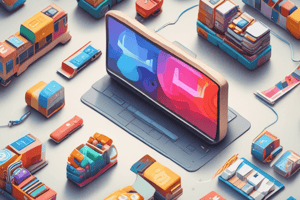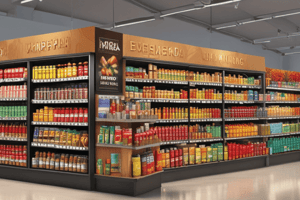Podcast
Questions and Answers
What is the purpose of maintaining minimum inventory levels?
What is the purpose of maintaining minimum inventory levels?
- To prevent shortages and lost sales (correct)
- To increase storage costs
- To eliminate the need for a reorder point
- To encourage overstocking
Which of the following is a benefit of automation and digitalization in inventory management?
Which of the following is a benefit of automation and digitalization in inventory management?
- Slower inventory tracking
- Enhanced efficiency and reduced errors (correct)
- Higher storage costs
- Increased manual errors
How does inventory purchase impact the profit and loss account?
How does inventory purchase impact the profit and loss account?
- Eliminates need for cost management
- Directly impacts costs (correct)
- Increases revenue immediately
- Reduces current assets
What does the reorder point signify in inventory management?
What does the reorder point signify in inventory management?
What is the importance of supply chain collaboration in inventory management?
What is the importance of supply chain collaboration in inventory management?
Which function is NOT essential for transferring goods in distribution channels?
Which function is NOT essential for transferring goods in distribution channels?
What is NOT a common evaluation standard for channel participants?
What is NOT a common evaluation standard for channel participants?
Which of the following is a cause of conflict in distribution channels?
Which of the following is a cause of conflict in distribution channels?
Which participant is NOT typically involved in the distribution process?
Which participant is NOT typically involved in the distribution process?
How have wholesalers adapted in response to IT advancements?
How have wholesalers adapted in response to IT advancements?
Which of the following is a key characteristic of commercial service companies?
Which of the following is a key characteristic of commercial service companies?
What percentage of total delivery time does order flow time constitute?
What percentage of total delivery time does order flow time constitute?
What type of market institution facilitates trade through structured platforms?
What type of market institution facilitates trade through structured platforms?
Which strategy could be used to shorten order-to-delivery time?
Which strategy could be used to shorten order-to-delivery time?
Which of the following is NOT an advantage of retail and wholesale trade forms over earlier trade methods?
Which of the following is NOT an advantage of retail and wholesale trade forms over earlier trade methods?
What key aspect is crucial for ensuring accurate deliveries?
What key aspect is crucial for ensuring accurate deliveries?
Which company is mentioned as an example of reducing delivery time significantly?
Which company is mentioned as an example of reducing delivery time significantly?
What is the main goal of improving communication between customers and suppliers?
What is the main goal of improving communication between customers and suppliers?
What is one of the expected results of optimizing logistics systems?
What is one of the expected results of optimizing logistics systems?
What aspect of logistics is emphasized for protecting goods during transit?
What aspect of logistics is emphasized for protecting goods during transit?
What is a key feature of logistics-oriented organizations necessary due to globalization?
What is a key feature of logistics-oriented organizations necessary due to globalization?
What is the primary benefit of palletization in logistics?
What is the primary benefit of palletization in logistics?
Which type of packaging is primarily focused on transport efficiency?
Which type of packaging is primarily focused on transport efficiency?
What are developed countries mainly emphasizing to combat packaging waste?
What are developed countries mainly emphasizing to combat packaging waste?
What is the economic advantage of containerization in sea transport?
What is the economic advantage of containerization in sea transport?
Which statement about the types of packaging based on material type is correct?
Which statement about the types of packaging based on material type is correct?
Which of the following describes the disadvantages of using rail transport?
Which of the following describes the disadvantages of using rail transport?
What system in Germany assists with ensuring packaging recyclability?
What system in Germany assists with ensuring packaging recyclability?
How does air transport contribute to cost savings in logistics?
How does air transport contribute to cost savings in logistics?
What is a disadvantage of using rail transport?
What is a disadvantage of using rail transport?
Which inventory valuation method uses older stock first?
Which inventory valuation method uses older stock first?
What is a key benefit of using water-based transport?
What is a key benefit of using water-based transport?
Which of the following factors does NOT influence transport mode selection?
Which of the following factors does NOT influence transport mode selection?
What technique minimizes inventory by syncing production with demand?
What technique minimizes inventory by syncing production with demand?
Which transportation mode is described as slow and unsuitable for time-sensitive goods?
Which transportation mode is described as slow and unsuitable for time-sensitive goods?
What is a major trend in inventory management?
What is a major trend in inventory management?
Which factor is usually considered in inventory management to minimize costs?
Which factor is usually considered in inventory management to minimize costs?
Flashcards
Market Research in Distribution Channels
Market Research in Distribution Channels
The process of gathering information about potential customers, their needs, and market trends.
Channel Management in Distribution
Channel Management in Distribution
The process of evaluating, selecting, and motivating the companies involved in moving a product from producer to customer.
Conflicts in Distribution Channels
Conflicts in Distribution Channels
Issues arising due to conflicting interests, goals, or roles between different participants in a distribution channel.
Trading Companies in Distribution
Trading Companies in Distribution
Signup and view all the flashcards
Physical Distribution in Channels
Physical Distribution in Channels
Signup and view all the flashcards
Retail Trade in Distribution
Retail Trade in Distribution
Signup and view all the flashcards
Commercial Service Companies
Commercial Service Companies
Signup and view all the flashcards
Market Institutions in Distribution
Market Institutions in Distribution
Signup and view all the flashcards
Order Flow Time
Order Flow Time
Signup and view all the flashcards
JIT Systems
JIT Systems
Signup and view all the flashcards
Logistics-Oriented Organizations
Logistics-Oriented Organizations
Signup and view all the flashcards
Enhanced Communication Links
Enhanced Communication Links
Signup and view all the flashcards
Protection of Goods
Protection of Goods
Signup and view all the flashcards
Ensuring Accurate Deliveries
Ensuring Accurate Deliveries
Signup and view all the flashcards
Manipulation of Goods
Manipulation of Goods
Signup and view all the flashcards
Functions of Packaging
Functions of Packaging
Signup and view all the flashcards
Transport Packaging
Transport Packaging
Signup and view all the flashcards
Reusable Packaging
Reusable Packaging
Signup and view all the flashcards
Collective Packaging
Collective Packaging
Signup and view all the flashcards
Waste Management in Packaging
Waste Management in Packaging
Signup and view all the flashcards
Palletization
Palletization
Signup and view all the flashcards
Containerization
Containerization
Signup and view all the flashcards
Transportation modes
Transportation modes
Signup and view all the flashcards
Internal Transportation
Internal Transportation
Signup and view all the flashcards
Inventory Turnover
Inventory Turnover
Signup and view all the flashcards
Minimum Inventory Levels
Minimum Inventory Levels
Signup and view all the flashcards
Reorder Point
Reorder Point
Signup and view all the flashcards
Just-In-Time (JIT) Inventory
Just-In-Time (JIT) Inventory
Signup and view all the flashcards
Delivery Time
Delivery Time
Signup and view all the flashcards
Distribution Channels
Distribution Channels
Signup and view all the flashcards
Road Transportation
Road Transportation
Signup and view all the flashcards
Rail Transport
Rail Transport
Signup and view all the flashcards
Water-Based Transport
Water-Based Transport
Signup and view all the flashcards
Inventory Management
Inventory Management
Signup and view all the flashcards
Inventory Valuation Methods
Inventory Valuation Methods
Signup and view all the flashcards
Inventory Management Techniques
Inventory Management Techniques
Signup and view all the flashcards
Economic Order Quantity (EOQ)
Economic Order Quantity (EOQ)
Signup and view all the flashcards
Study Notes
Functions and Flows in Distribution Channels
- Essential functions for transferring goods include market research, establishing contacts, adjusting and negotiating, and financing risk assumptions.
- Transfer flows result in value transfer between producers and consumers.
Rating of Participants in the Channel
- Effective management requires evaluating, selecting, and motivating channel participants.
- Common evaluation standards include sales quotas achieved, average inventory levels, delivery times, and handling of damaged goods.
- Cooperation in promotions and education is also important.
Conflicts in Distribution Channels
- Causes of conflicts include mismatched goals, undefined roles and rights, and differing interests with high interdependence.
- Resolution strategies include setting shared higher objectives, exchanging personnel between channel levels, and co-opting individuals in advisory roles.
- Mediation by third parties is a strategy for chronic issues.
Participants in the Distribution Process
- Key participants include producers, trading companies, trade service providers, and consumers.
- The impact is enhanced sales and distribution quality without significantly increasing costs.
Changes in Wholesale Trade
- Wholesalers adapt to various formats like cash & carry, rack jobbing, and catalog and truck wholesale, driven by IT advancements.
- Wholesale faces redundancy due to increasing distribution costs.
Retail Trade Companies
- Companies sell directly to consumers through various formats, including classic stores, mobile stores, supermarkets, hypermarkets, boutiques, vending machines, catalog, and discount stores.
Retail and Wholesale
- Advantages include a better connection between production and consumption, higher productivity, and improved capacity utilization over earlier trade forms.
Commercial Service Companies
- Include trade agencies, public warehouses, forwarding companies, advertising agencies, and specialized distribution companies.
- They provide services like quality testing and logistics.
Market Institutions
- Market institutions include stock exchanges, auctions, and sample fairs.
- Their role is to facilitate trade through structured platforms.
Elements of the Logistics and Distribution System
- Composed of interconnected elements including ordering and delivery, storage and inventory management, handling and transportation, and information logistics systems.
Orders and Deliveries of Goods
- Order flow time constitutes up to 75% of total delivery time.
- Goals include shortening order-to-delivery time, improving communication between customers and suppliers, protecting goods from damage and theft, and ensuring delivery accuracy.
Shortening Order Times
- Examples include KARSTADT (JIT system) reducing delivery time to 40 hours, AHLSTROM reducing processing time from 6 weeks to 1 week, and NASHUA reducing preparation time from 8 hours to 1 hour.
- Fast delivery is a competitive advantage in developed markets.
Communication Links Between Customers and Suppliers
- Enhanced communication is possible through electronic systems like EDI (e.g., Wal-Mart) and integrated distribution centers equipped with advanced conveyor belts.
- Results include reduced costs and increased efficiency.
Protection of Goods
- Focuses on packaging and handling during transport, and choosing appropriate carriers and materials for sensitive goods.
- Example: EU companies follow strict standards for packing and handling various goods.
Ensuring Accurate Deliveries
- Delays can hamper manufacturing schedules and customer satisfaction.
Logistics-Oriented Order Flow Organization
- Globalization necessitates centralized logistics teams for order flow control, efficient production networks spanning multiple countries, and examples include computer parts produced globally and assembled in key markets to facilitate movement.
Manipulation of Goods
- Activities to facilitate movement within the logistics system include packaging goods in suitable materials and safeguarding goods from theft, damage, and environmental factors.
- Ease of storage and transport, enhancing product presentation, and informing consumers about product details are other important aspects.
Packaging Types and Criteria
- Criteria include role in the logistics system, service life, material type, and amount of product.
- Packaging costs vary by product (e.g., sugar in bulk 1% vs. coffee packets 50%).
Waste Management in Packaging
- Challenges include packaging waste becoming useless after unpacking.
- Developed countries emphasize recycling and waste reduction, and various examples such as EU regulations and Germany's "Green Dot" system are discussed.
- Additional information on costs related to waste packaging disposal is also included.
Palletization
- Palletization is a system for transporting goods on pallets, which reduces labor force needs and saves space while reducing handling costs.
- Various types of pallets, benefits of this system, and examples of modular packaging systems optimizing pallet space utilization are also included.
Containerization
- Containerization involves transporting goods in standardized containers for efficiency and cost saving.
- Economic advantages include savings on packaging costs, reduction of damage and theft risks, and streamlined customs processes.
- Lower insurance premiums due to reduced risk are also mentioned.
Transportation as an Element of Business Logistics
- The classification of transport is based on infrastructure, logistics role, organization, and territorial features.
Pros and Cons of Various Transport Modes
- Different transport modes (truck, rail, ship, airplane, pipeline) are discussed.
- Pros and cons of each mode are outlined. Cost-effectiveness and adaptability are important considerations.
Higher Environmental Impact
- Higher environmental impact of transportation modes is discussed.
- Factors influencing transport mode selection (cargo type, weight, perishability, distance, route characteristics, transport economy, past experiences).
Rail Transport
- Advantages, weaknesses, slowness, risk of damage, and increasing importance due to energy costs and environmental concerns from rail transportation are explored.
Water-Based Transport
- Suitability for bulk goods of low individual value.
- Types, benefits, and limitations of river, canal, and maritime transport are outlined.
Inventory Management
- Key components and functions of managing raw materials, work-in-progress, and finished goods to ensure production continuity and meet customer needs, reducing shortages, and optimizing procurement.
Inventory Valuation Methods
- Common methods include FIFO, LIFO, average cost, and specific identification.
- Impact on financial statements is also considered.
Inventory Management Techniques
- Key methods like EOQ, JIT, and MRP are explained.
- EOQ balances ordering and holding costs, and determines optimal order quantities.
- JIT minimizes inventory, syncs production with demand, and reduces waste and storage costs.
- MRP ensures timely availability of materials for production.
Reorder Point, Delivery Time, and Inventory Turnover
- Reorder points trigger automatic restocking, delivery time is between order and arrival, and inventory turnover optimizes stock levels.
- Examples are provided.
Trends in Inventory Management
- Emerging trends like automation and digitalization, predictive analytics, eco-awareness, and fast delivery are explored.
- Supply chain collaboration is also considered, specifically sharing inventory data with partners for better planning.
Inventory and Financial Impacts
- Inventory is shown as current assets within the balance sheet.
- Increases in inventory increase assets, while decreases decrease assets.
- Inventory purchases affect cost within the profit and loss account.
Proper Inventory Management
- Proper inventory management ensures a balance between costs and revenue.
- Increased inventory leads to higher assets but also higher storage costs.
Studying That Suits You
Use AI to generate personalized quizzes and flashcards to suit your learning preferences.





